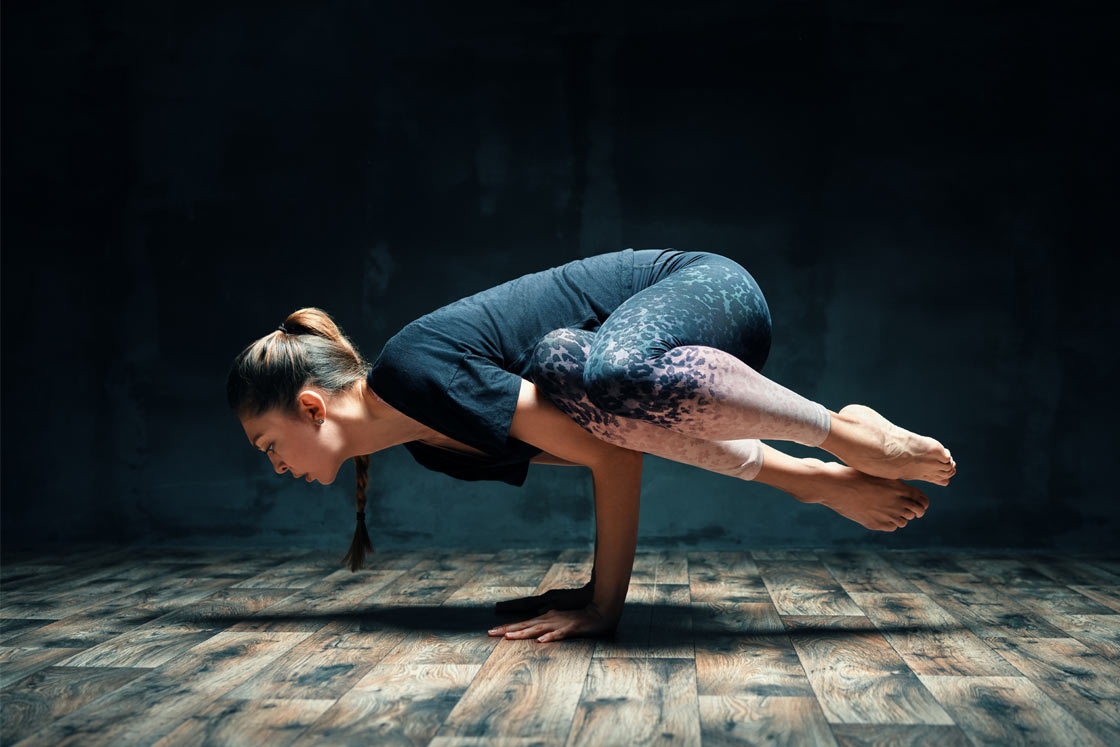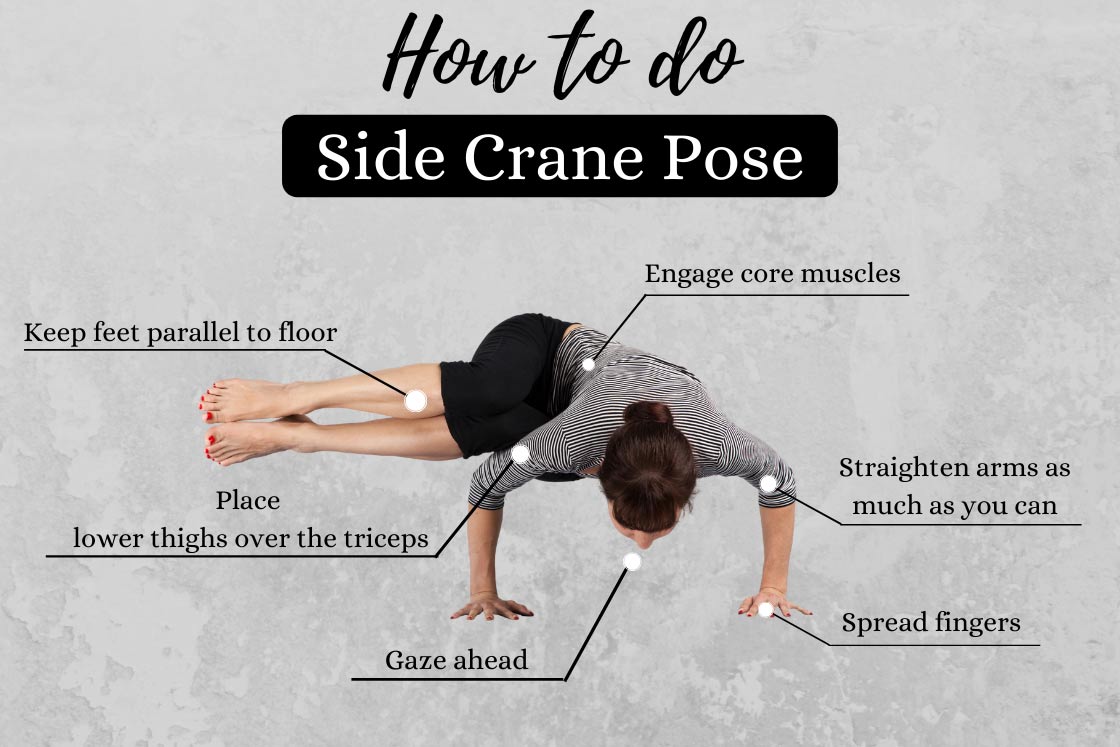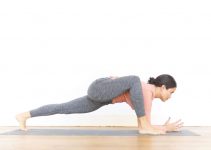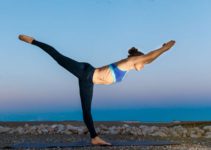
After the regular practice of Bakasana/Crane Pose, you will find Parsva Bakasana easier to perform. Now, it is time to take it to the next level. For flexibility, you should give a try to Parsva Bakasana/ Side Crane Pose.
Side crane pose is an advance version of Bakasana, It is an intermediate balancing asana, in which, you have to hold your whole body-weight on your arms and palms.
It mainly focuses on the following body parts and muscles.
- Abdomen and core(abs)
- Upper and lower back
- Arms and shoulders
Like Bakasana, in this pose, we lift our feet off the floor and balance our weight on the wrist and palm. But, here we place our both legs on the same sides, once on the left side, once right.
How to Do Side Crane Pose?

Side Crane Pose is quite similar to the Crane Pose. You just need to sweep your legs on the sides instead of tucking the knees under armpits. You need to follow the following steps to perform Parsva Bakaasana easily.
This Asana can be performed by two methods.
Method I
-
Preparing the Asana
1. Firstly, stand tall and straight. Now spread your feet apart, as much as you are comfortable (about one leg-length apart).
2. Now, bend forward from your waist and place your palms on the floor. The hands should be shoulder-width apart and spread the fingers apart.
Take a few breaths here, gazing straight.
-
Getting into the Pose
3. Bend your arms a little from your elbows. At the same time, lift the heels of both legs and come to your toe balls.
4. Bend your right leg from kees and move the right knee or lower thigh over to the right tricep. Then place its lower thighs on the left triceps. This leg (right) should be parallel to the floor.
Here your right knee will be slightly ahead of your left tricep and its lower thigh would be touching the tricep. Since the right shin should be close to the left knee.
Note- You have to bend your right leg a little bit to maintain the balance.
5. Now, bend your elbows more, lean forward and lift the right leg off the floor. Then, place the left leg over right, maintaining the body balance with your arms.
You can keep your legs bent, or extended, according to your comfort. But, make sure, they are parallel to the floor.
6. Now, straighten the arms as much as you can. If you bend the arms more, it forms Parsva Kakasana/ Side Crow Pose.
Note- Here, most of the pressure will be on your left hand.
7. Hold the position for 10-30 seconds, breathing normally.
8. When you are done, slowly bring both legs back and come to the initial position. Take a few deep breaths here.
This is the Side Crane pose from the left side and it has to be done with both sides. So, repeat the whole same procedure with the right side.
-
Releasing the Asana
9. When you completed the process with both sides, then simply come to the initial position (at step 2).
10. Now, slowly bend your knees and lift your hands off the floor simultaneously.
11. Then, either come to Vajrasana or straighten the legs and relax.
Now let’s see what is another method to perform Side Crane Pose
Method II
-
Preparing the Pose
1. Stand straight on the top of a yoga mat in Tadasana/Mountain Pose.
2. Then, bend your knees and come bings the hips down i.e come into a squat position and balance your weight on your toe-balls.
3. With an exhalation, twist your torso towards the right, keeping the legs in the same position. Now, place palms in front of you, flat on the floor and keep them shoulder-width apart. Spread the fingers apart from each other.
Note- You can turn your legs a little towards right, but not excessively. The angle between your chest center and legs should be at least 45degrees.
-
Coming to the Asana
4. With an inhalation, fold your arms a bit, and lean forwards a little.
5. Now, bring the sides of your right leg’s thighs over to the left tricep.
6. Inhale, bend your arms a little more and lift both legs off the floor, placing left leg above the right.
Here your left arm will be supporting the legs, hence getting more pressure.
7. Try to keep both legs parallel to the floor and keep the arms straight as much as you can. If you bend elbows further, it forms Parsva Kakasana/ Side Crow Pose. Either keep the legs folded or straighten them, depending on your comfort.
Now breathe normally and hold the pose for 10-30 seconds.
8. When you are done, bring both legs back and come to the initial position ( at step 2). Take a couple of deep breaths here.
This is the Side Crane pose from the left side. Now, repeat the whole same procedure with the right side.
-
Releasing the Asana
8. When you have performed the above procedure from both sides, then simply come to the initial pose (step 2)
9. Now, either come to Vajrasana or straighten the legs and relax.
Beginner’s Tips and Suggestions
- In the beginning, you can place another hands elbow, under the side of the hip for extra support. For example, if your performing Side Crane Pose from the left side, then place the right hands elbow under the side of the left hip.
- You can place a yoga block under your palms for extra grip and support.
- Place a heap of pillows or some soft things in front of you, so that, if you fall forward, you don’t get hurt.
- Take the help of any partner or instructor to maintain the balance and also to perform this asana correctly.
Precautions and Contraindications
- Do not go beyond your body limit. Perform this asana according to your strength and caliber.
- Do not wear slippery cloths like silk cloths during this asana. It can cause problems in placing your legs on triceps.
- Spread the weight evenly among the wrist, fingers, and palm. Do not center it only on the wrist.
- Do not perform this asana if you have a serious or deep injury in arms, shoulders, core or back. As this asana mainly focuses on these parts of the body, so, performing this asana in such injuries can be harmful to you. Also, avoid this asana if you have Carpal Tunnel Syndrome or Spondylitis.
- Performing this asana during pregnancy is not good for a lot of pressure on the core, which is not good for the fetus. So do not perform this asana during pregnancy. Also, avoid this asana during menstrual cycles.
Preparatory poses
- Chaturanga Dandasana ( Four-Limbed Staff Pose)
- Adho-Mukha Shvanasana (Downward-Facing Dog Pose)
- Pasasana (Noose Pose)
Follow-Up Pose
- Vajrasana (Thunderbolt Pose)
- Uttanasana (Standing forward bend)
Benefits of Side Crane Pose
Side Crane Pose gives the same benefits to the body as Crane Pose, but in an increased amount. Let’s see what are the benefits of Parsva Bakasana.
- As this asana puts a lot of pressure in the arms, strengthens the whole arm, and makes it more flexible and strong. Also, it stretches the elbows and wrists, making them more flexible and strong.
- This asana massages the core and abdominal organs. It helps in toning abdominal organs such as the pancreas, kidneys, liver, intestines, etc. Thus it helps in detoxification and digestion process of the body.
- Parsva Bakasana stretches the back and improves the blood flow to the spine. It improves the alignment of the vertebral column and keeps the spine healthy.
- This asana is supposed to stimulate the Manipura/Solar Plexus Chakra, which boosts self-confidence and self-control. This asana also helps in bringing the sensations of self joy and calmness.
- Side Crane Pose builds overall body strength and flexibility. It teaches us to bring balance to our body. It prepares us for further intense asanas.
Conclusion
Fear of falling is the biggest thing that hinders us to perform Side Crane Pose. So, the practice of this asana starts from the mind, before the physical body.
The biggest obstacles in the way of doing anything are the ones we create in our minds. The same thing applies here also. You need to train your mind at first.
Practice this asana with a fully prepared mind, and then you will find it easy.
Side Crane Pose FAQs
Is Side Crane Pose/ Parsva Bakasana harder then Crane Pose/Bakasana?
Yes, Side Crane Pose/ Parsva Bakasana a little harder the Crane Pose, as most of the pressure occurs on a single hand, which is a little hard to maintain.
But with practice, you will master it easily.I get shivering in my body when I perform Side Crane Pose/ Parsva Bakasana for more than 15 seconds. Is it normal?
Yes, it is normal to get shivering and vibrations if you are trying to perform it longer then usual. Don’t worry! With practice, all the shivering will be gone.




